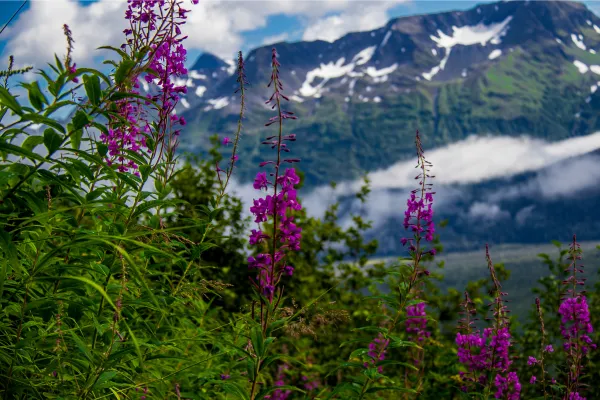
What Mule Deer Eat in the High Country: A Guide to Summer and Fall Forage
“Forage is seasonal, but habits are patterned. Understand one, and you’ll unlock the other.”
When you’re scouting for big mule deer bucks, understanding what they eat is vital for recognizing big buck country and locating big bucks. Mule deer aren’t grazers like elk. They’re browsers. That means they don’t just mow down a meadow—they selectively feed on a variety of forbs, shrubs, and grasses depending on season, elevation, and what's available.
Summer and early fall in the high country offer some of the best forage of the year. This is the critical window when bucks rebuild from winter, put on weight, and prep for the rut and the next round of snow. If you want to find mature bucks consistently, you need to know what they’re eating and where it grows.
Browsers, Not Grazers: How Mule Deer Feed
Mule deer browse—selectively feeding on high-protein plants that fuel antler growth, body weight, and overall health. They’re picky for a reason. Bucks won't waste energy traveling to poor feed when they can bed close to the good stuff. That’s why you’ll often glass them up in high-country basins, avalanche shoots, and tucked-away meadows where forage is lush and hunting pressure is low.
The best feeding zones combine:
A variety of nutritious plants (especially high-protein forbs)
Proximity to bedding cover
Low human pressure
As the seasons shift, so does the menu. Summer meals are rich in soft forbs and grasses, while fall brings more woody browse into their diet like bitterbrush, sage, and mahogany.
Let’s break down what these bucks are actually eating.
High-Protein Forbs: Fuel for Early Season Growth
These plants are key for bucks in the summer and early fall. They provide the nutrients needed for rapid weight gain, antler development, and recovery from winter.
Sticky Geranium (Geranium viscosissimum)
Wildflower with dark green, deeply lobed leaves and sticky stems
Purple-to-lavender flowers in loose clusters
Found in open meadows, forest clearings, and trails from mid to high elevation
Biscuitroot (Lomatium species)
Low-growing with feathery, bluish-green leaves
Umbrella-like clusters of tiny yellow or white flowers
Found in dry, rocky soils, sagebrush country, and ridges

Lupine (Lupinus species)
Palmate, fan-like leaves
Tall flower spikes in deep blue, violet, or white
Thrives in high meadows, forest edges, and roadsides
Monument Plant / Elk Weed (Frasera speciosa)
Large rosette of lance-shaped leaves
Can grow a stalk up to six feet tall with pale green, speckled flowers
Found in high meadows and moist slopes
Sunflowers (Helianthus species)
Tall with heart-shaped, rough leaves and bright yellow flowers
Found in meadows, disturbed soils, and sunny hillsides
Fireweed (Chamerion angustifolium)
Reddish-purple stem with magenta flowers blooming from bottom up
Found in burns, clearings, and alpine meadows
Hollyhock (Iliamna species)
Large, velvety leaves with showy pink-to-rose flowers
Found in moist high meadows, streambanks, and aspen groves
Shrubs and Browse: Key Late-Season Forage
As forbs dry out and temps drop, mule deer shift toward woody browse to meet their energy needs. This is when you’ll find bucks keying in on the following shrubs and small trees.
Big Sagebrush (Artemisia tridentata)
Silvery-green, narrow fuzzy leaves with strong aroma
Found in dry foothills and high desert areas
Includes three primary varieties:
Wyoming Big Sagebrush – Compact and drought-resistant
Basin Big Sagebrush – Taller and found in well-watered basins
Mountain Big Sagebrush – Upright and common in higher elevation forests
Antelope Bitterbrush (Purshia tridentata)
Small, waxy, three-lobed leaves with fragrant yellow flowers
Dense, interwoven branches
Found in dry foothills and rocky mountain slopes
Gambel Oak (Quercus gambelii)
Deeply lobed dark green leaves that turn orange and red in fall
Gnarled bark, often forming dense thickets
Found in foothills and canyon country
Quaking Aspen (Populus tremuloides)
Smooth white bark with trembling, flat-edged leaves
Turns brilliant yellow in fall
Common in high-elevation basins, north slopes, and stream corridors
Serviceberry (Amelanchier species)
Oval, serrated leaves with white spring flowers and edible berries
Grows on ridgelines and forest edges

Mountain Mahogany (Cercocarpus species)
Evergreen shrub with small, curled, leathery leaves
Produces long, feathery seed tails
Found on rocky ridges and dry slopes
Russet Buffaloberry (Shepherdia canadensis)
Silvery-green, scaly leaves with reddish-orange berries
Found in foothills, riverbanks, and mixed forests
Final Thoughts: Let the Feed Guide Your Glass
Understanding mule deer feed isn’t just about botany—it’s about behavior. Bucks will spend the majority of their summer and early fall within striking distance of the best groceries. So when you’re glassing high-country basins or picking apart timber pockets, use your knowledge of forage to eliminate dead ground and hone in on high-probability zones.
Mature bucks don’t just appear—they grow fat and smart in places where the feed is rich and the pressure is low. Know their menu, find their kitchen, and odds are you’ll find the kind of buck that makes all those miles worth it.



